Your toothbrush is a vital tool for maintaining oral health, helping to remove plaque and bacteria from your teeth. However, it’s important to give your toothbrush the care it needs to stay effective. Here, we’ll discuss common mistakes people make with toothbrush care and how to ensure your toothbrush is doing its best job for you.
Things You Should Avoid with Your Toothbrush
To get the most out of your toothbrush and reduce bacterial exposure, it’s essential to avoid some common storage mistakes and hygiene pitfalls.
Don’t Store Your Toothbrush in a Dark, Damp Space
Storing your toothbrush in a closed cabinet or container may seem like a good idea, but it can lead to unwanted bacterial growth. Bacteria thrive in dark, moist environments with limited airflow. By keeping your toothbrush in a place with proper ventilation, such as an open holder on your bathroom counter, you’re creating an environment that reduces bacterial buildup.
Avoid Sharing Your Toothbrush
It’s crucial not to share your toothbrush with anyone, including children. Sharing can transfer bacteria between users, increasing the risk of tooth decay and gum disease. Even if you’re only lending your toothbrush for one-time use, it can still introduce harmful bacteria to both parties. Using separate toothbrushes helps maintain good oral hygiene for everyone in the household.
Keep Your Toothbrush Away from the Toilet
Surprisingly, the distance between your toothbrush and the toilet matters. Bathrooms can contain airborne particles from flushing, which may spread bacteria. To minimize exposure, store your toothbrush at least six feet away from the toilet and always close the lid before flushing. This small step can go a long way in keeping your toothbrush cleaner.
Proper Care Tips for Your Toothbrush
Maintaining your toothbrush is simple but requires a few consistent habits to ensure it remains in good condition and effective at cleaning your teeth.
Replace Your Toothbrush Regularly
Replacing your toothbrush every three to four months is essential. If you notice frayed bristles, it’s a clear sign that your toothbrush is past its prime. Worn bristles are less effective at removing plaque, so regular replacement ensures your toothbrush remains efficient. Additionally, if you’ve been sick or recently recovered from a cold, replace your toothbrush to prevent reinfection.
Rinse and Clean Your Toothbrush After Each Use
After every brushing session, thoroughly rinse your toothbrush with water to remove debris and bacteria. For a deeper clean, occasionally swish your toothbrush in mouthwash to disinfect it. This simple step helps reduce bacteria and keeps your toothbrush fresh between uses.
Store Your Toothbrush Upright and Let It Air Dry
After cleaning, store your toothbrush upright in an open area, allowing it to air dry. This helps prevent mold, bacteria, and other unwanted contaminants from building up. Avoid laying your toothbrush flat, as moisture can become trapped, leading to bacterial growth.
Remember to Pair Toothbrush Care with Regular Dental Visits
Taking care of your toothbrush is just one part of maintaining good oral hygiene. Regular dental visits are equally important for overall dental health. By combining diligent toothbrush care with professional cleanings, you’re setting yourself up for a healthier smile.
At California Dental Group, we encourage all our patients to stay proactive about their oral hygiene. For your next dental appointment, give us a call at 800-407-0161 to schedule a visit. Our team is here to support your journey to optimal dental health.


